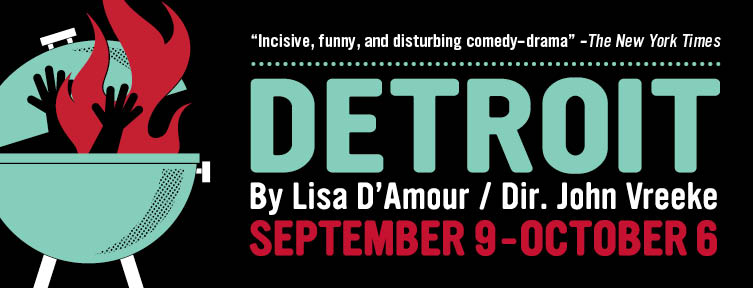Are you able to walk up to your neighbor’s house and borrow a cup of sugar? Does anyone even do that anymore? Or is it just easier to go down to the 24-hour food mart and buy what you need rather than trying to determine if you have a functioning relationship with your neighbor? Do you even know the people that live next door? A compelling, yet highly humorous, socio-economical commentary on the devolution of neighborhoods in modern America is what comes to the stage to kick off Woolly Mammoth Theatre Company’s 34th Season: America’s Tell-Tale Heart.
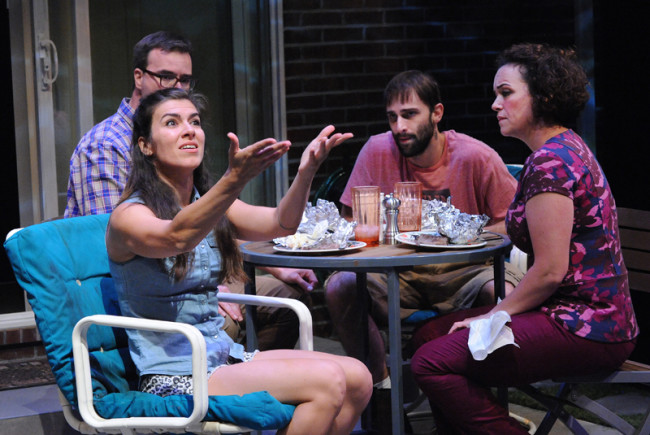
This area premier of Lisa D’Amour’s Detroit falls on the recent news of the city of Detroit declaring bankruptcy and is the perfect examination of the nation’s current economic crisis. With rich characterizations that unearth the desperation in all human beings when it comes to financial stability and surviving, this production is a firecracker to anchor their new season. Directed by John Vreeke, the production provides a comical yet deeply profound look at the way humans become defined by their economic situation.
The play itself is a magnificent examination of the human species in times of financial turmoil, but the stage’s setting, conceptualized by Scenic Designer Tom Kamm, is truly remarkable. Shifting the layout of Woolly Mammoth’s internal theatre space, Kamm sets the audience in a tennis-court fashion, building two houses opposite one another with their backyards touching in-between. Kamm’s attention to detail is authentically stunning; with siding and brick on the houses’ exterior, with detritus in the rain gutter of the unsettled house, everything has a sharp realistic appearance. Kamm’s decision to make these two backyards and houses so realistic calls the audience’ s attention to the fact that these two homes could very easily be their own homes and that of their neighbor’s. The visual atmosphere created is really astonishing and quite a good bit to take in.
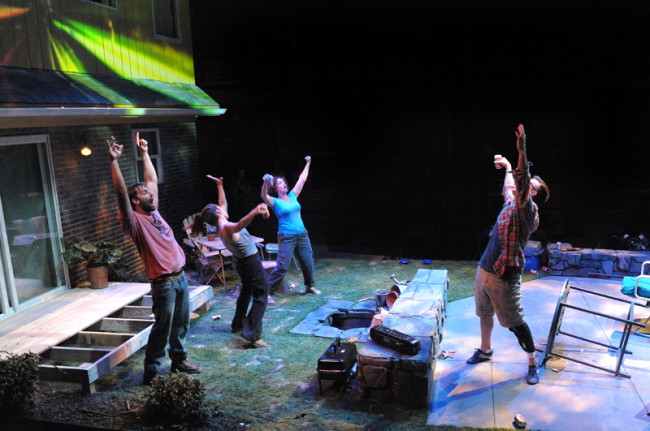
Complimenting these two enormous structures in Kamm’s design work are the visual effects created by Lighting Designer Colin K. Bills and the Video Design provided by Erik Pearson. Pre-show and during the scene crossfades, Pearson projects video images of neighborhoods, from both times gone by and the present day, onto the two houses, creating a rather stunning aesthetic as the images distort slightly over the windows and splits in the brick and siding. Bills make distinctive shifts in the play’s timeline with night and day, night being accompanied by further video projections; and when the emergency vehicles respond to the houses near the end of the production Bills captures the epitomical essence of what fire engines, police cars, and ambulance lights look like coming through the windows into the back yard. These visual elements aid in the harsh reality of the play’s existence, pulling the audience into its existence.
Sound Designer Christopher Baine grounds all of the intense visualizations with sounds of familiarity. Sprinklers on lawns, dogs barking, cars rolling slowly down residential streets. All of these common neighborhood sounds echo throughout the piece in seemingly sporadic yet well-timed intervals; once again reminding audiences of where they are and what they are experiencing.
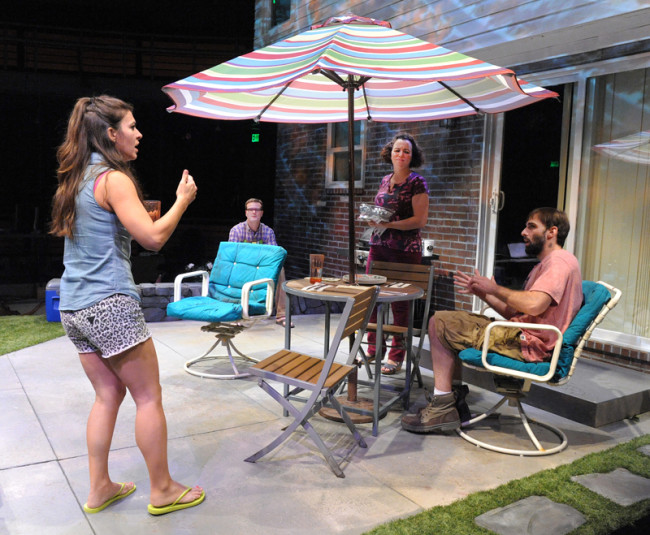
Director John Vreeke works in a simplistic yet beautiful fashion to let D’Amour’s work speak for itself. The focus of the production is really an explorative commentary on economic structure and how it has matriculated into even the most basic of human relationships; that which we share with our neighbors. Vreeke guides the five performers to find an honesty in the depths of the characters’ dialogues, letting the charades of their existences and marriages unravel and shine through in the moment rather than forcing sharp contrasts between the two personalities that live within each character. D’Amour uses unconventional tactics to expose these strained relationships in the economy, including humor; a brilliantly relatable way to address a drastic situation while keeping the audience from becoming too bogged down in the gravity of the situation.
The two couples have an inexplicable organic energy between them; Ben (Tim Getman) and Mary (Emily K. Townley) welcoming the newer couple to the neighborhood in a methodic, almost robotically chipper fashion, akin to the ‘Stepford’ vision of a community. Townley starts off inadvertently treating the new couple like low-class simpletons with a persistent grin on her face. But her character is much deeper than the initial encounter leads on. Townley gives a rousing rendition of a drunk character teetering on the edge of sanity, crying out and making lamentations that make sense only to the inebriated. When her world slowly unravels and the façade of her marriage and perfectly well-constructed economically stable life begins to shatter, Townley unearths a richly damaged character that she presents well with emotional outbursts.
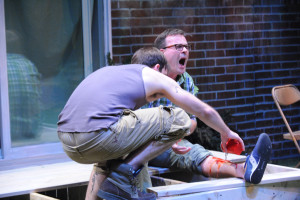
Playing her husband, Tim Getman is the iconic representation of the upper-middle class yuppie situated quietly in the suburbs. His character is also much deeper than meets the eye, confessions that don’t come bursting out until close to the end of the production. Getman plays his character with close-to-the-chest reservations, making his moments of outburst truly explosive and that much more dynamic. His man-to-man scene with Kenny is the pinnacle of change in his life; an eruption of personal freedom that spirals upward and downward simultaneously for his character’s trajectory in the story. Getman and Townley share an awkward chemistry, befitting of their marriage, and as their lives begin to shake apart they become exceedingly well at honestly displaying their inner truths, which are not nearly as polished and pretty as they led on.
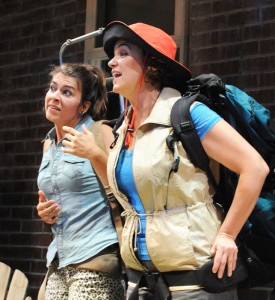
The new neighbors, Kenny (Danny Gavigan) and Sharon (Gabriela Fernàndez-Coffey) bring a humorous element to the show right from the beginning. The arrive on the scene without much sophistication or polish, as evidenced in their physicality and speech patterns. Gavigan is the more rough around the edges of the two, but is wildly passionate when it comes to finding freedom in his lifestyle. Fernàndez-Coffey is the real dynamite in the show. She carries a good deal of heavy emotionally bombastic monologues that truly address the grit of society, especially when it comes to her life as an ex-substance abuser. Giving the most dynamic performance of the show, Fernàndez-Coffey gives a heart-wrenching confession to Mary about slipping off the wagon and how her world is quickly spiraling out of control because of her need for substances.
Hilarity and chaos ensues as the play journeys on, a feat need to be witnessed to truly enjoy it. Michael Willis makes a brief appearance at the end of the production, a construct designed by D’Amour to tie up loose ends in the story; but his closing monologue is one of the most poignant in addressing the thematic elements of the show. A brilliant performance that is topical to everyone in the nation at present; thoroughly infused with belly-bursting humor to keep everyone aware but entertained while enjoying this vibrant new work.
Running Time: Approximately 110 minutes with no intermission
Detroit plays through October 6, 2013 at Woolly Mammoth Theatre Company— 641 D Street NW in Washington, DC. For tickets call the box office at (202) 393-3939 or purchase them online.

